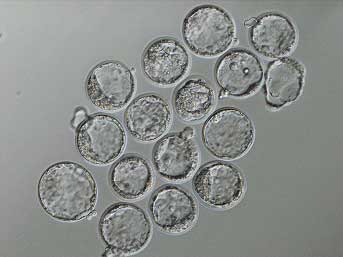| RIKEN Center for Developmental Biology
(CDB) 2-2-3 Minatojima minamimachi, Chuo-ku, Kobe 650-0047, Japan |
A straightforward new tweak developed by the Wakayama lab now presents the first significant increase in mouse cloning efficiency in recent years. This step forward, published in the December 9 online edition of Biochemical and Biophysical Research Communications, was achieved by researchers who treated the NT zygotes with the histone deacetylase inhibitor, trichostatin A (TSA), thereby boosting efficiency to an unprecedented 6%.
The reasons for the difficulties in the cloning of mammals have been proposed to stem back to incomplete or incorrect reprogramming of the nucleus following transfer into the oocyte. The chromosomes of differentiated cells carry molecular markers that specify which genes are to be expressed and which shut down, helping to specify the patterns of gene expression, and so, the form and function of such cells. In natural fertilization, the information sets contained with nuclei of the sperm and egg are reprogrammed as the two cells fuse, enabling the ontogeny of a unique new individual. But when a differentiated nucleus is introduced directly into an oocyte as is done in cloning attempts, this reprogramming frequently appears to go awry. The molecular signatures involved are written in a script of methyl groups that adorn genes directly and the acetylation of histone complexes that package the DNA into tightly coiled bundles, but it is a mystery how the oocyte opens up this intricate code for revision. Research scientist Satoshi Kishigami and Wakayama had previously observed hypermethylation of DNA following the transfer of immature round spermatids into oocytes, later finding that treatment of the oocytes with TSA prior to transfer eliminated this abnormality. This led them to conjecture that TSA might act to quell hypermethylation and improve the ability of transferred nuclei to be reprogrammed correctly. Working first with cumulus donor cells, they experimented with different timing and dosages of TSA treatment and found that exposure to 5nM of TSA for 10 hours following nuclear transfer improved development to the blastocyst stage (a yardstick commonly used to measure NT success) to 75%, as compared to 20% in the control group, a result that also suggests that hypermethylation takes place in the first few hours following the activation of the recipient egg. Additional experiments using nuclei from tail-tip fibroblasts and spleen lymphocytes met with similarly improved success rates. The positive effects of TSA treatment translated into higher live births as well, with 6% of all attempts leading to the birth of pups (against only about 1% for control). These animals were found to be healthy and normal in all respects, save for the enlarged placenta that typifies all cloned mice, and importantly, do not exhibit the obesity and shortened life expectancy seen in some other mouse clones in the past. Interestingly, when the donor nucleus was taken from an ES rather than a somatic cell, TSA had the opposite effect, and no clones developed to term. ES cells are in themselves excellent nuclear donors, as their DNA methylation is naturally low; unmodified cloning by ES cell nuclear transfer generally sees 2~6% success in producing live pups. The picture presented by these findings is that methylation may be a determinant of success that is highly dosage-sensitive. TSA appears to be a positive addition to the technique for establishing ntES cell lines, which are embryonic stem cell lines derived from blastocysts created by nuclear transfer. TSA treatment increased efficiency by two or threefold, and the ntES cells so created were found to express all of the molecular markers characteristic of ES cells, including Oct3/4 and Nanog.
|
||||
|
||||
[ Contact ] Douglas Sipp : sipp@cdb.riken.jp TEL : +81-78-306-3043 RIKEN CDB, Office for Science Communications and International Affairs |
| Copyright (C) CENTER FOR DEVELOPMENTAL BIOLOGY All rights reserved. |
